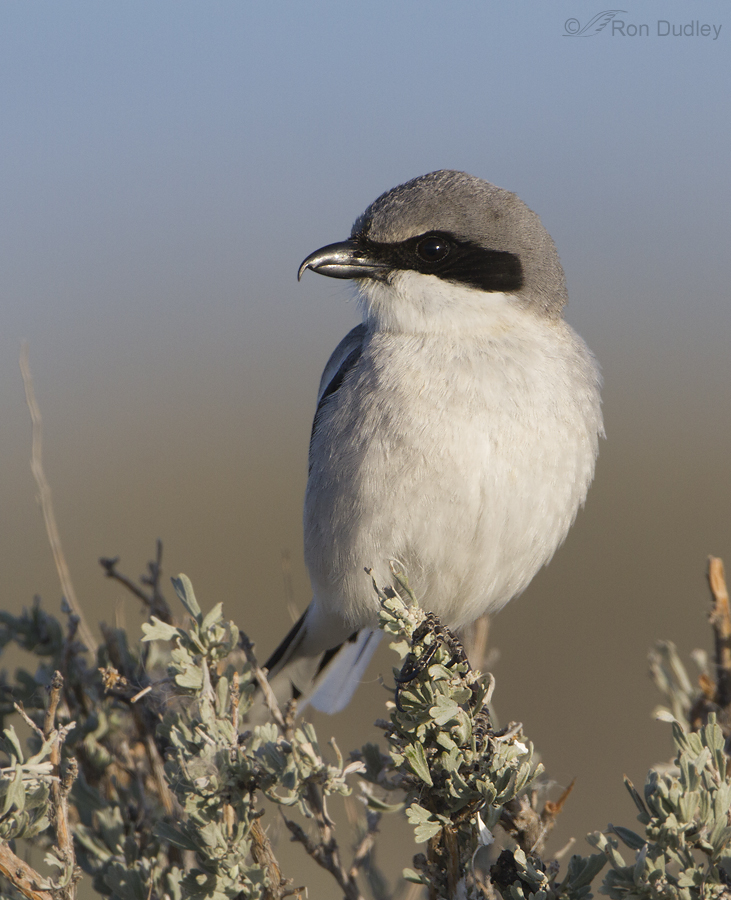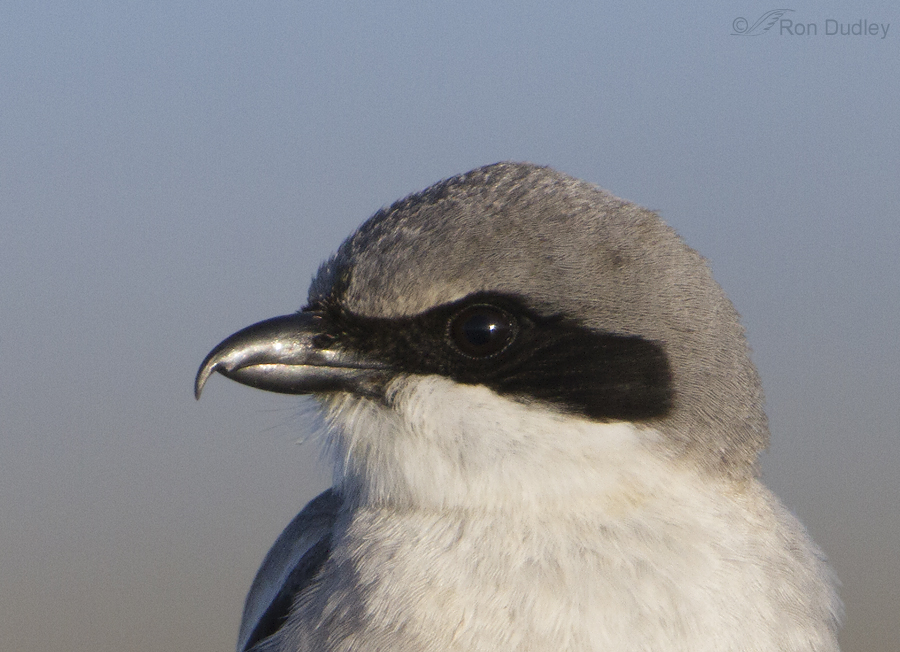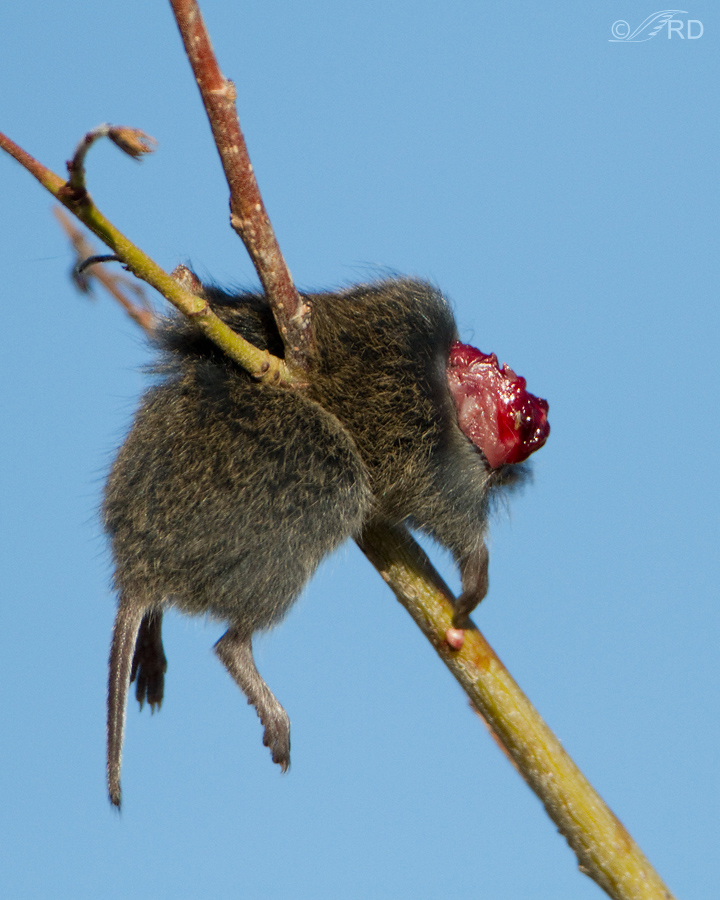Shrikes have been called “raptor wannabes” for good reason. Their small size and relatively innocuous appearance belies their aggressive disposition and killer instinct. They feed on insects, spiders, amphibians, small reptiles, birds and mammals.
Despite their diminutive stature, shrikes have most of the tools needed for killing their prey and tearing it apart, including a very sharp hooked bill and “tomial teeth” – projections on the upper mandible that allow them to sever the spinal cord of their vertebrate prey. These adaptations are also found in falcons and are used for the same purposes. But shrikes are missing the strong talons of the typical raptor (they are songbirds, after all) so they can’t hold their prey down with their feet while ripping off chunks of flesh. To compensate they’ve developed “impaling behavior” where they impale their prey on sharp projections like thorns or barbed wire to anchor it as they pull the prey apart.
But I’ve never been able to get a really good look at both the hook and tomial teeth in my shrike images, until two days ago on Antelope Island.
This Loggerhead Shrike let me get close enough and the light on the bill was just right to show the best bill detail I’ve been able to get. As you can see, the bill is sharply hooked and the tomial “tooth” on the upper mandible is clearly visible.
An extreme crop of the same image shows them both even better.
Note: The next (and last) image of this post is a little gruesome so if you’d like to avoid it, scroll no further).
Another name for shrikes is “butcher bird” and this image demonstrates why (I’ve posted this shot once before). This is a vole that has been wedged (works just as well as impaling) in the notch of a tree by a Loggerhead Shrike at the Antelope Island campground. Doing so serves two purposes for the bird – food storage and it provides an anchor for the shrike to pull against when it wants a meal.
Interestingly, they sometimes adorn the carcass with feathers in an apparent effort to attract a mate.
If you’d like to see this impaling/feeding technique in action I highly recommend that you watch this video clip from National Geographic. Even National Geographic has succumbed to the sensationalist narration style I find so annoying on the History Channel and elsewhere but the clip itself is excellent for the behavior.
Ron





We may have actually seen one of these birds early this spring…was a brief visit…never, ever got to see one before…haven’t seen it again. I was excited to see it, pretty sure of the ID,but they remind me of terrorists…even have an executioner’s mask…yet, are they any worse than we are with our freezers full of dead chickens, cows and pigs???
I refuse to believe that pretty bird did that – tell us it’s not so!
That is a truly efficient beak. What an amazing photo. Antelope Island seems to have been very good to you this trip. Again. Your happy hunting grounds (so to speak). And as dinahmow says, a very pretty bird as well.
Ron, great “cropped head” shot of the vole as well! Sorry, I couldn’t resist…
Thanks as always for the education!
Cheers,
Dick
Awesome post Ron! That beak does look deadly.
It is deadly, Steve. Thank you.
I learned so much from this post. Great shots of the bill. I didn’t realize they ate voles and lizards. I’ve seen insects like grasshoppers impaled, but these others were surprises. Thanks for the post from National Geographic (and I agree about the voice.) It was interesting to see how the acacia was utilized to help tear the prey.
Janet, I’ve never seen a shrike eat a reptile but I’ve sure seen them with voles they have killed. They’re deliciously messy eaters too.
Here is a bird which was regular in the 60’s in the Province of Quebec and which is now extirpated from the province since about 20 years now. Very sad. Lost of habitat is the main cause. Thank you to show us so amazing pictures of this nice predator.
That’s very sad, Laval. Habitat loss is responsible for so much of this kind of thing.
What a great shot! Love the cropped head shot.
You had to have been real close for this shot, I envy your experience!! Nice job, well done.
Thanks, Dick. Yes I was close, especially considering it’s a shrike.
Brilliant shot!And what a pretty bird. I’ve tried, often, to get close-ups of our Australian butcher birds and generally failed miserably! they can become so tame in suburban habitat as to accept food from the hand [no, I don’t do this and discourage it in others], but posing for camera? Nope, don’t wanna, not gonna!
Diane, Our shrikes are generally difficult to approach – in fact I’d say they’re one of our spookiest passerines. I can’t imagine hand feeding one of them…